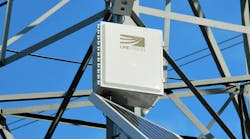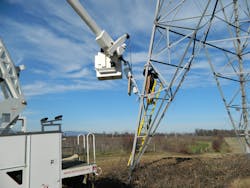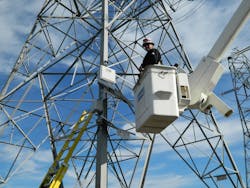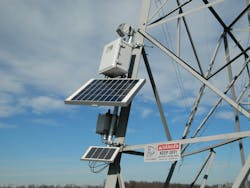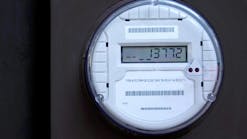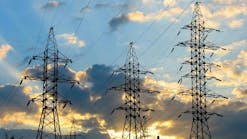By Terron Hill, Director of Clean Energy Development, National Grid
The world is standing on the precipice of a historic energy transformation that will determine whether the tipping point of irreversible climate change can be reversed to ensure a sustainable future. Reshaping electricity networks with renewable, clean and resilient energy solutions is key to moving a sustainable future forward. T&D electricity grids are the conduit that deliver energy from the generation sources to end users, and electric utilities will be at the center of how to rethink the grid to meet this challenge. National Grid is ready to answer the call.
Most U.S. states have enacted aggressive climate mandates in recent years, including the states in which National Grid operates. New York state has set a goal to increase renewable generation to at least 70% by 2030 and reach net zero by 2040. Massachusetts has laid out similarly aggressive climate goals, with a reduction in emissions to 50% below 1990 levels by 2030 and net zero by 2050.
What does this transition look like on the ground? According to the U.S. Department of Energy, utility-scale wind energy is expected to grow by some 110 GW by 2030, for a total of 224 GW, and an additional 180 GW by 2050, for a total of 404 GW. It is not just wind power, of course. Utility-scale solar generation also is quickly growing and expected to surpass a total of 250 GW by 2029.
The climate crisis also has inspired a rapidly morphing electrification appetite to achieve the net-zero goal more quickly. Electric vehicles, solar panels and battery storage installations in American homes are expected to grow nine times faster than traditional power plant generation in the coming years. With all this growth, utilities must work to ensure distributed energy resources are integrated safely. National Grid has taken a variety of steps to meet this challenge head on.
Infrastructure Overhaul
The electric utility industry has never seen an overhaul of existing energy infrastructure at this scale — at least not since the bulk of the U.S. grid was built in the 1930s. Utilities are working diligently to ensure infrastructure is equipped to exceed critical climate goals. It is estimated billions must be spent to achieve net zero, including significant investment in transmission networks. A 2019 report by the Brattle Group for WIRES, the international trade association that promotes investment in all aspects of the high-voltage grid, estimated the U.S. needs to spend between $30 billion to $90 billion to meet 2030 electrification demands, and more than $230 billion by 2050.
Utilities are tasked with integrating record levels of renewable energy assets, accommodating dramatically increased multidirectional power flows and hardening the grid to prepare for increasingly severe weather events exacerbated by man-made climate change. Yet, a vast amount of infrastructure needs to be revamped, as much of it was built more than 50 years ago.
Existing Grid Assets
National Grid serves more than 20 million people throughout New York and New England. The utility continues to honor a long-standing commitment to its customers and the regions it serves to ensure the most efficient and modern power delivery methods are available. While the utility must build new transmission to accommodate the energy transition, permitting and construction can be a lengthy process. Given the urgency of the climate crisis, the utility has sought alternative solutions to bridge the gap. It is taking steps today to make the existing grid perform better.
National Grid is working to make its transmission systems more efficient, flexible and resilient by harnessing new grid technologies to optimize existing assets and help to ease the energy transition. Until recently, utilities have been forced into conservative operations of transmission assets because of a lack of available technologies to provide the data needed to ensure safe and reliable operation. However, the tremendous untapped capacity of these assets can be unlocked by optimizing and enabling them to carry increased loads.
It is National Grid’s mission to ensure it can meet the ambitious climate goals by facilitating renewable generation and clean energy through its networks while maintaining a reliable, resilient and safe grid that benefits customers. Through its affiliate National Grid Ventures, which owns and operates offshore wind, solar and terrestrial wind, it is helping to lead the way to a clean energy future through innovative solutions to maximize the performance of its existing grid assets.
Grid-Enhancing Technologies
National Grid has begun exploring and integrating a suite of grid-enhancing technologies aimed to optimize the grid and give system operators better visibility to the capacity of the utility’s entire electric transmission network. Studies have shown using grid-enhancing technologies can double the integration of renewables onto the grid and dramatically accelerate the energy transition, which also has a profound impact on job creation within the renewable energy economy.
One prime example of this work is with LineVision, a firm that uses light detection and ranging (LiDAR) to continuously monitor overhead power lines and increase the usable capacity on the grid. The company’s sensor and data analytics platform uses noncontact sensors mounted on transmission towers to monitor line conditions in real time; assess how much electricity they can carry safely; and, in turn, increase line capacity when conditions permit, without physical upgrades to the system. The technology enables National Grid effectively to build new transmission capacity without constructing new lines.
The technology includes sensors that collect important data on overhead power lines, such as line temperature, sag, horizontal motion and other anomalies. This data alerts National Grid about potential problems before they happen, which can prevent costly power interruptions. The utility is using the technology to assess the health of its energy delivery system, obtain greater situational awareness and optimize existing transmission capacity, enabling it to meet the goals of net zero by 2050 — and do it faster.
National Grid has gathered data that shows LineVision’s dynamic line ratings (DLR) outperform traditional static ratings 94% to 97% of the time. Static transmission line ratings currently are common practice in the industry, and very conservative assumptions are made for the environmental operating conditions of a power line if no sensors are monitoring the real-time conditions. The resulting static line rating, the maximum amount of power that can be put on a circuit, is very conservative.
However, National Grid’s studies have shown, by using DLR, the capacity of its transmission lines can be increased by approximately 31% over ambient adjusted ratings and 45% over static ratings. That is a significant bump in capacity, especially given the sheer number of renewables the utility is trying to put on the grid.
National Grid also is working with Smart Wires, a provider of power flow control technology. Smart Wires is helping the utility to decarbonize its grid by enabling greater volumes of renewable power to be transferred efficiently to underutilized transmission lines through modular power flow control technology.
Among other technologies, National Grid is exploring the use of transmission asset robots from Kinectrics that test the strength and resilience of lines without damaging them. The utility also is using battery storage technology in a bid to prevent the need for new transmission in cases where lines are near capacity during peak periods. On the island of Nantucket in Massachusetts, the utility built a 6-MW/48-MWh battery energy storage system, the largest of its kind in New England. Because of the rapid growth in electricity demand on the island, the battery was introduced as a solution to serve as an energy source during peak summer months. It enabled the utility to avoid the installation of a new undersea cable to the island for 15 years.
Opportunities
There are significant opportunities to increase the delivery of renewable energy over existing transmission lines, and National Grid’s use of these technologies is enabling the utility to lead the clean-energy transition and put it on the path to meet and exceed New York state’s renewable energy goals.
As the utility collectively looks to temper the impacts of climate change, investing in the grid is a requirement. Getting the most out of the assets National Grid already has is an efficient way to maximize the existing transmission capacity and enable the integration of more renewables more quickly.
Terron Hill ([email protected]) is director of clean energy development for National Grid. In this role, he is responsible for pushing forward new innovations to help transition the utility’s network to deliver a clean energy future.
Terron Hill
Terron Hill is director of transmission network strategy at National Grid. He is responsible for infrastructure investments on National Grid’s U.S. electric transmission grid and deployment of new innovative technologies to enable National Grid’s vision of an intelligent transmission network that facilitates the evolving needs of customers and a decarbonized energy future. Hill is a graduate of Cornell University.
